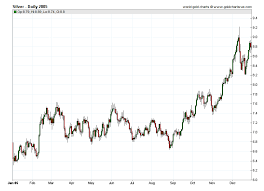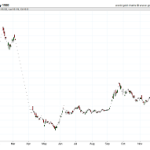The year 2005 was a significant year for the silver market, marked by considerable fluctuations in price and influenced by various factors such as global economic conditions and geopolitical events. Silver prices ranged from $6.39/oz to $9.23/oz, with a high degree of volatility throughout the year.
This article aims to provide an analytical overview of the silver market in 2005, exploring the factors that impacted prices and the trends and fluctuations observed throughout the year. To achieve this goal, this article will draw upon historical and current silver price data, as well as relevant news articles and reports from the time.
The article will begin with an overview of the year 2005, highlighting key economic and geopolitical events that shaped the global market. It will then delve into the factors that influenced silver prices, including supply and demand dynamics, changes in investor sentiment, and shifts in global economic conditions.
Finally, the article will examine the fluctuations and trends observed in the silver market throughout the year, providing readers with a data-driven and objective analysis of this dynamic market.
Overview of 2005
The year 2005 saw fluctuations in silver prices, as evidenced by the daily silver price data provided and the LBMA silver price fix history data used. These fluctuations were influenced by various factors such as supply and demand, global economic conditions, and geopolitical events. The overall trend for silver prices in 2005 was upward, with prices increasing from $6.39/oz on January 4th to $9.23/oz on December 30th.
The silver market in 2005 was influenced by several price drivers. One of the main drivers was the increasing demand for silver in industrial applications, particularly in the electronics industry. The rise in demand was due to the growing popularity of electronic devices such as smartphones and laptops, which require silver for their production. Additionally, geopolitical events such as the conflict in Iraq and the threat of terrorism led to a rise in demand for silver as a safe haven asset.
Overall, the silver market in 2005 was characterized by fluctuations driven by a combination of supply and demand, global economic conditions, and geopolitical events.
Factors Affecting Prices
Various market conditions and global events can be likened to gusts of wind that can either propel or hinder the movement of a sailboat, affecting the value of a certain precious metal such as silver.
In 2005, silver prices fluctuated due to the constant changes in supply and demand dynamics, as well as various geopolitical and economic events. The silver market was affected by the rise in global demand from developing countries such as China and India, while the supply was affected by the declining production of silver from major producers such as Mexico, Peru, and China.
Moreover, the market analysis showed that the silver prices were also affected by the fluctuations in the US dollar and other major currencies, as silver is denominated in US dollars. The weakening of the US dollar against other currencies, particularly the euro and the British pound, led to an increase in the demand for silver as a hedge against inflation.
The geopolitical events, such as the war in Iraq and the tension between the US and Iran, also played a significant role in the fluctuations of silver prices in 2005. These events led to the uncertainty in the global market, which resulted in the increase in the demand for safe-haven assets such as silver.
Fluctuations and Trends
Global economic and geopolitical events continue to impact the value of silver, as evidenced by the fluctuations seen in the market in 2005. During this year, silver prices experienced significant changes, with the prices ranging from $6.39/oz to $9.23/oz.
The highest price was observed on November 17, 2005, at $8.10/oz, while the lowest price was recorded on August 31, 2005, at $6.74/oz. These fluctuations were caused by various factors, including supply and demand, currency fluctuations, and global economic conditions.
The effects of these fluctuations were felt by investors and stakeholders in the silver industry. For instance, higher silver prices would translate to higher revenue for producers and miners in the industry. On the other hand, lower silver prices would result in reduced profitability and even losses for these stakeholders.
Looking ahead, predictions for future trends in silver prices will continue to be influenced by a wide range of factors, including global economic conditions, geopolitical events, and supply and demand dynamics. These predictions will help investors and stakeholders in the industry to make informed decisions regarding their investments and operations.
Frequently Asked Questions
What were the main industries or sectors driving demand for silver in 2005?
In 2005, the main demand drivers for silver were the electronics and photography industries, which accounted for approximately 60% of total silver consumption. Other industries, such as jewelry and silverware, also contributed to demand. The supply chain was supported by primary silver production and recycled scrap.
How did the price of silver in 2005 compare to other precious metals such as gold and platinum?
Silver’s market share compared to other metals in 2005 was lower, with gold and platinum commanding higher prices. Speculation played a role in silver prices, but supply and demand, economic conditions, and geopolitical events were also factors.
Were there any significant geopolitical events in 2005 that impacted the price of silver?
Geopolitical influences and economic indicators played a significant role in affecting the price of silver in 2005. The US dollar, oil prices, and global political tensions were among the key factors that impacted the silver market.
How did the price of silver in 2005 compare to previous years?
The price of silver in 2005 was relatively low compared to previous years, with an average price of $7.32/oz. The impact of global economic conditions, including a strengthening US dollar and rising interest rates, contributed to the decline in price.
What was the average daily trading volume of silver in 2005?
The average daily trading volume of silver in 2005 is not provided in the given background information. However, major players in the market such as banks, hedge funds, and institutional investors are likely to have contributed significantly to the overall trading volume.





